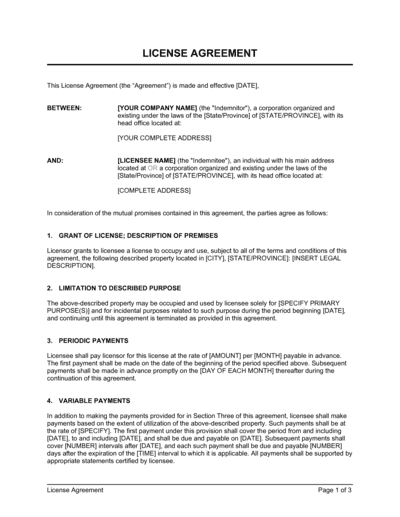

Establishing clear permissions and constraints regarding the use of proprietary assets is crucial in the intricate landscape of intellectual property and commercial rights. A License Agreement serves as the bedrock for this purpose, creating a legal framework that delineates the terms under which one party can use the property owned by another.
This agreement is an essential instrument, specifying the scope of the license, including what is being licensed, the territory in which the license applies, the duration of the license, and any exclusivity provisions. It not only governs how licensed properties—such as software, patents, trademarks, or copyrights—are utilized but also ensures the protection of the licensor’s rights while enabling the licensee to exploit these rights within agreed boundaries. This document transcends mere permission; it is about structuring a relationship that optimally balances operational freedom with intellectual property security.
A License Agreement template serves as a foundational guide that spells out the critical components necessary for licensing arrangements. This includes detailed clauses on the scope of granted rights, financial terms like royalties or lump-sum payments, obligations of the licensee regarding the use of the licensed material, and the consequences of violating the terms. Employing a template ensures a comprehensive approach to agreement creation, allowing for customization to reflect the specific nature of the intellectual property and the commercial goals of both parties while promoting a clear, mutual understanding of the licensing terms.
A robust License Agreement should thoroughly address:
Identification of Parties - Clearly defines the licensor and licensee involved in the agreement.
Description of the Licensed Material - Specifies what intellectual property is being licensed, including details that clearly identify the scope of the material.
Grant of License - Outlines the nature of the rights being granted, including any limitations on these rights such as non-exclusive, exclusive, or sole licensing.
Financial Terms - This section details the financial obligations, such as royalty payments, licensing fees, and any other compensation arrangements.
Territory and Duration - Specifies the geographical area where the license applies and the period for which the rights are granted.
Usage Rights and Restrictions - This section defines how the licensed property can be used, any restrictions on its use, and responsibilities like maintaining trademark standards or patent markings.
Termination and Renewal - Conditions under which the agreement can be terminated or renewed, including breach consequences and notice requirements.
Intellectual Property Protection - Provisions for the protection of the licensor’s rights, including audit rights and measures against infringement.
To enhance the effectiveness and comprehensiveness of a License Agreement, integrating related documents is advisable:
Utilizing a detailed template for drafting your License Agreement offers significant benefits:
Adopting a comprehensive License Agreement is essential for managing the complexities of intellectual property usage in business operations. It provides a clear, enforceable framework that safeguards the rights of the licensor while granting the licensee the ability to utilize these rights within defined limits, supporting mutual benefits and compliance with applicable laws.